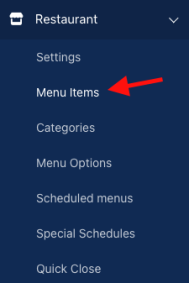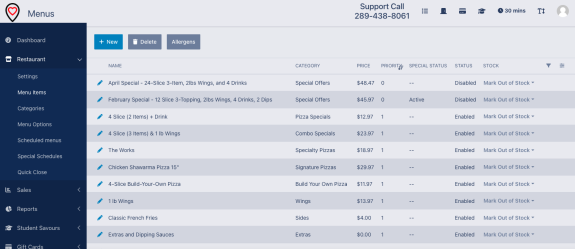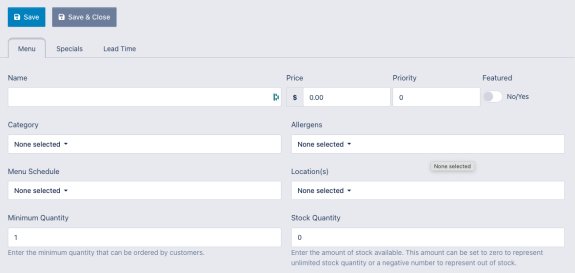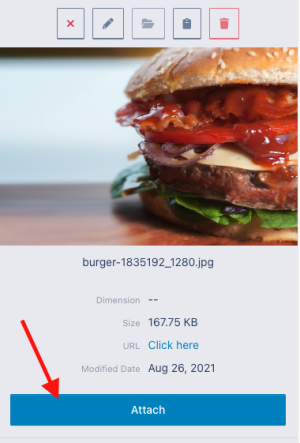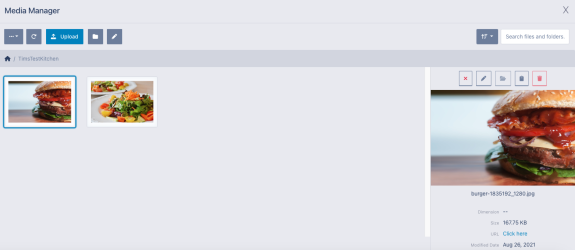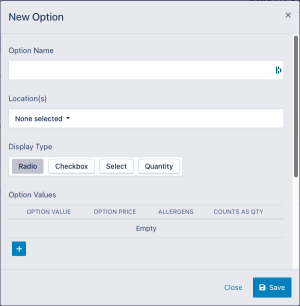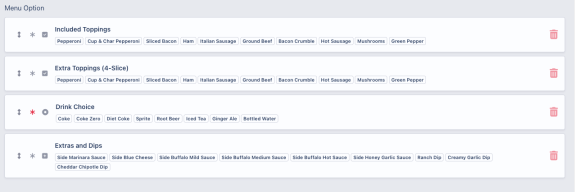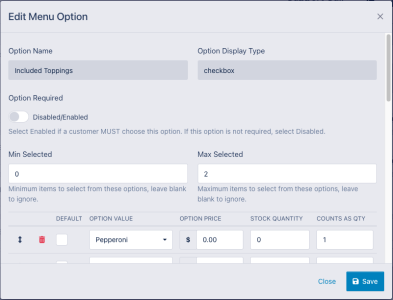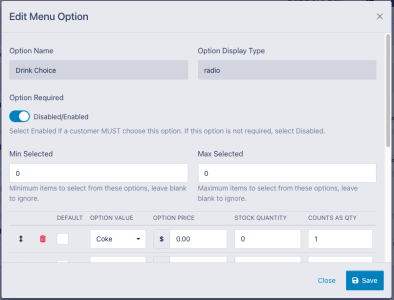Menu Item Management and Settings
The heart of your restaurant is your menu, and this is where the rubber hits the road for ordering setup. Menus are made of of two main components, the menu item and it's options (sometimes called modifiers). You will use the Menu Item Management page to set up both of these.
To access the Menu Management page, go to Restaurant -> Menu Items in the left menu when you are logged in to the admin panel as manager.
Menu Items List
When you first go to the Menu Items page you will be presented with a full list of all of your menu items.
Your full menu list can sometimes be difficult to navigate unless you have a very simple menu, but you can quickly navigate and filter your menu by using the filter feature. To add filters to your menu, click the funnel icon at the top right of the list header and the system will add the ability to filter the menu by category or status, or to search the menu for a specific phrase.
Most frequently when we are working with menus, we use the filters feature to show just a single category of items so that we can easily work on the items in that grouping at one time. For menus that have been around for a long time with lots of items being added and removed (disabled) over time, we will use a combination of the category and status to get the items that we specifically want to see and work with.
We also use these filters when we are creating a new menu to ensure that as we add new items we are seeing just what will show up in that category on the menu page when a customer is ordering.
Add a New Item
Adding a new item is generally a multi-step process unless your new item is very simple and has no photo or options (modifiers).
Adding the Base Item
To create a new item, click the '+ New' button at the top of the menu list. You will be taken to the new 'base item' page where you can set up the basics of a new item.
From this page you are essentially setting up the "shell" of a new item, or a very basic item in your system. You will first create the basic menu information:
- Name The item name. This will also be what shows up on your order tablet as the item, so make sure that it is descriptive so you know what it is. For example you may sell a Roast Beef Sub as well as a Roast Beef Wrap and you may group them into different categories for Hot Subs and Wraps. Despite the fact that the item shows up on the menu under Sub or Wrap, it won't be clear to you which item was ordered if you name them both "Roast Beef" in the system. We highly recommend making the name descriptive so you would have a "Roast Beef Sub" and a "Roast Beef Wrap" item separately so that your staff can handle orders accurately.
- Price This will be the regular price for the base item without any options. For example, you might offer a small and large French Fries, but to simplify the menu and user ordering experience you would set up a menu item for French Fries and set the Price to be the price of the Small french fries. We can add the option later to choose the size which will include the upgrade cost for the large sized fries.
- Priority The priority is the order in which the items will appear under each category in ascending order. This is an integer (number) value and we usually recommend using values that are spaced out to allow for easier additions and editing later (for example: 10, 20, 30, 40). If you do not assign a priority, the items will be sorted in the order in which they were added to the system. This is optional and depends on how you want your menu to appear to your customers.
- Featured If you set the item to be featured, it will always appear at the very top of your menu as well as in the category you have defined. If you have items flagged as featured there will be a new "Featured" category added at the top of your menu with all items set for feature, regardless of the other categories they may appear in.
- Category You should always assign your menu item to one or more categories. A single item can belong to multiple categories if you choose, for example you may want to include your "Chicken Wrap Combo" in both your Wraps category as well as a "Featured Items" category. Most commonly, however, menu items belong to just one category to avoid repetitiveness in your menu and to keep the length of your menu to a minimum for ease of ordering.
- Allergens You can specify any allergens for the menu item such as Keto, Gluten Free, Sugar Free, Vegan, etc. We have a full set of Allergen markers and categories available for you in this list. If you see something missing that is important in your menu, please let us know and we will get it added. Note that we allow customers to filter your menu and the list of restaurants on the platform based on the existence of some of these allergen tags, so if you offer Keto, Vegan, Gluten-Free, etc dishes it is important to mark them as such using the Allergens list.
- Menu Schedule If your menu item is only available during specific times of day, days, or on a specific date, that can be controlled using Menu Schedules. You need to set up menu schedules in the system before you can tag a menu item to it. Note that if you specify a menu schedule, the item will only be available to your customers during that schedule, and will appear as unorderable (or won't be visible) at any other time.
- Location(s) You must specify which locations this menu item is available at. If you have only one location or brand that you manage, you will find that this list only has your one location listed, but either way the location is required to set up a new item.
- Minimum Quantity This is a very infrequently used setting, but we do allow you to set a minimum order quantity for a menu item. For example a customer may be required to order 6 of an item. In general we find this confusing for customers and we would recommend instead setting the item up as a bundle of the minimum quantity. For example the name of the item would be "Jalapeno Poppers (6)" and then the minimum quantity can remain 1.
- Stock Quantity If you know you will have a limited number of a specific item you can set a stock quantity and the system will automatically make the item unavailable on your menu once that runs out. This is infrequently used as most restaurants prefer to simply mark an item out of stock when it runs out rather than managing a count of inventory in the system, recognizing that you may also receive orders in person or by phone. If you leave this field defaulted to 0 then there will be no limits placed on the item and you can manage out of stock situations through the tablet as normal.
- Order Restriction You can restrict the menu item to only be available for a specific order type (pickup or delivery). This is helpful for special pick-up discounts you might offer, or items that you want to make exclusively available for delivery. While this isn't used often, it can be a handy feature for specific promotions.
- Subtract Stock Coupled with the Stock Quantity field, enabling this setting will cause the system to reduce your "Stock Quantity" with each order until you run out and the item becomes unavailable.
- Description This is the same as the description of your menu item on your printed menu. It should help the customer clearly understand what they are ordering and can include details like the types of choices they get to make when they order. Keep in mind that this is a free-text field and it is not automatically updated when you change menu options later, so we usually recommend leaving option prices and sometimes even the specific menu option choices to be more vague in the description. For example, list that the item "includes your choice of side or upgrade" instead of "your choice of french fries, chips, or upgrade to onion rings for $2.19 or poutine for $3.49" so that you don't need to remember to change the description when you change pricing.
- Image You can not set an image until the base item is set up. Leave this alone at this point.
- Status Generally you will want to create your new item as enabled, however sometimes you may want to create the item as disabled (not available to order or visible on your menu) so that you can add the menu options and other details before it becomes available on the front end menu. If the status is enabled it will generally be visible to the customer and can be ordered. If it is disabled it is not available or visible on the customer side.
- Maximum Quantity You can limit the number of an item that your customer can order on any individual order. Set this value to 0 for unlimited, or specify the maximum quantity for special items and we will prevent over-ordering (including for variety of options) on an individual order.
- Hide if Not Available We have two different behaviours for menu items to the customer. Generally if an item is not available (due to a menu schedule restriction, a lead time restriction, or an out of stock condition) we would still show the item on the front end, but it will be greyed out with a note as to the reason why it can not be ordered right now. This is important so that customers know that you usually sell an item, but that it isn't available currently and why. If you set the item to be hidden when not available, we will not even show the item if it's unavailable - similar to it being disabled in the status. This is useful for items that are available only on a specific day or time (ie. a lunch menu) that you don't want to even be seen at other times. You should think carefully through how you want your menu item to appear to your customer before deciding how to set this flag.
- Menu Item Type Dine Local supports common rules for alcohol ordering and delivery, specifically the AGCO requirements that alcohol must be ordered with food items from restaurants when ordered for takeout. You should set this drop down to either Food (this is a food item that would qualify to be ordered with alcohol), Non-Food (this is non-food or alcohol, but it does not qualify as a partner to alcohol - for example a pop or a t-shirt), or Alcohol (this is an alcohol option which needs to be paired with food). This defaults to Food for simplicity and if you do not offer alcohol for takeout you don't need to worry about this field.
- Item Requires ID (19+) While we also categorize items as alcohol, food, etc you need to specify which items require ID for delivery. This can also apply to items that are not alcoholic, but for whatever reason may also require an ID verification. We use this flag for our own integrated delivery to identify orders which require special handling. If you do not set this flag properly, deliveries may not go out with a driver who is Smart Serve certified which can cause liability issues for both you and the driver network.
Once you have set up the base information on the main "Menu" tab, you are ready to "Save" your new menu item to the system.
Adding Images and Options and Completing the Menu Item
Once you have Saved your base menu item, you will note a change to the header of the page and the tabs that are available to you.
You now have a new tab for "Options" which is where we will set and manage your menu options (modifiers) for the item, as well as a new button that allows you to duplicate the item.
Once the item is saved, you can also add an image on the main 'Menu' tab by clicking on the blank image and selecting or uploading an image into your restaurant folder.
Adding an Image
To add an image, go to the "Menu" tab and scroll down to the "Image" field, then click the blank image with the plus sign to add a new image. (Note if you have already added an image you'll need to click the X first to remove the existing image before you can add an image.)
You will be presented with the Media page where you can select or upload an image from your restaurant library.
All images you have previously uploaded are available to you from this page.
To search for an image by filename you can type the name in the top right box and wait a second, and the list of images will be filtered. Delete the search text to return the list to all of your image files.
You can also upload a new image by tapping the blue "Upload" button at the top of the page. Dine Local supports JPG, PNG, or GIF images and we recommend sizing them for web as much as possible. The system will do its best to optimize large files, but a very large file will make the user experience negative while they wait for your picture to download.
It is also important to note that we do not support any special characters in file names. Please remove all punctuation characters from file names before attempting to upload a file or you will receive an error uploading.
Once you have the image you would like to attach to the menu item in the system you can click on it to highlight it, then choose the "Attach" button on the right pane to select it.
Adding and Managing Options
For many menus, options (otherwise known as modifiers) are critical to simplifying ordering. Dine Local has a robust options setup which allows for great flexibility in menu setup, but which can also be complicated when you work through the setup of your menu.
Click the "Options" tab at the top of your menu to go to the options setup for this menu item.
You have a few main items you can manage here:
- You can create a new Option set for this menu item that will be available for re-use on any other menu item in the future.
- You can choose an existing Option set that you previously set up and add it to this new menu item. This is useful for things like a "Choose a Side" option set that is common and used on all menu items in the "Mains" category of your menu. In this way, you can manage a single list of options (including choices, upgrade prices, etc) and have them apply to every menu item they are added to.
- You can choose an existing Option set that you previously set up and modify it. If you are updating pricing on your menu for example, you may want to just edit an option set from here and you can choose to have it update the options across all items that currently have it assigned.
- You can choose an existing Option set that you previously set up and duplicate it. If you have a need for the same list of items in an option set, but would like customers to be able to choose them in a different way this can be helpful. For example if you have a list of pizza toppings which has different prices depending on the pizza size, or a list of wing sauces but you allow customers to select only one for some sizes and multiple choices for other sizes.
- You can modify the existing options that are assigned to this item including setting requirements, minimums/maximums, item specific pricing, reorder options, or delete/remove options from an item.
Creating a New Option
To create a new option, click the "+ New Option" button to the right of the option drop down box.
To set up a new option set you will set the following:
- Option Name: Choose something concise, but which helps the customer and your staff know what this grouping is for. Simple phrases such as "Choose Your Side", "Included Toppings", or "Add Dips".
- Location(s): You need to select which locations will have access to this option set. For restaurants with only one location/brand this will only have one option, but it needs to be specified.
- Display Type: Dine Local supports four key option behaviours:
- Radio - users can select only one item from the list
- Checkbox - users can select one or more items from the list (can be restricted)
- Select - users can select only one item from a drop down (not a common use - not as user friendly)
- Quantity - users can select zero or more quantities of each item in the list (can be restricted)
- Option Values: You can add one or more option values to be available to the customer to choose from in this option set. Each item has it's own name, option price (price added to the cost of the menu item if selected), allergens (ie. gluten-free, vegan), or "counts as quantity" which is useful when you are restricting selections like included pizza toppings, but have premium toppings which count as two items when selected.
- Show Option In Order: By default you will want to save all options to your order so this should be set to ON except in very specific circumstances. For example, we sometimes will create an Option to improve customer experience such as "Need More Items?" which then will expand a dependent menu item for the customer to choose from. In this case, the selection of "Yes" is not required on the order itself and can be set not to save. Use this setting carefully.
- Sort Options By: By default options will be sorted manually in the order in which they are set up in the option set, but we have made it possible to ensure consistent sorting across items and option sets by specifying the sort order as:
- Manual Priority (default)
- Alphabetical (either A-Z or Z-A)
- By option price (either low to high or high to low)
- By counts as value (either low to high or high to low)
Once you have set up the option as you would like it to be available, click to 'Save' the option to the system.
Select and Attach a Menu Option to the Menu Item
Once you have a menu option set created, you can add it to the menu item you are working on.
Click the dropdown box for a list of all of your menu options.
If you have a long list, you can type in the search bar to restrict the options list to find the one you are looking for.
Select the menu option you would like to add to the menu item, and then click the "Add to Menu" button to the right of the dropdown.
The option will be added to the list of menu options automatically.
Select and Edit a Menu Option
If you need to make changes to a menu option set you can also do that from this screen. Simply select the menu option you would like to modify from the list and click the "Edit Option" button to the right.
Note that editing the option may affect all menu items that it is already added to. You can edit any of the option settings from the Add an Option set from the screen that pops up, and then you have an option to have the changes update all other menu items when you save.
We generally recommend always updating all other menu items when you save to ensure that things stay in sync. If you have a reason to have different pricing for the same options across multiple items we generally recommend setting up multiple option sets with the different prices to make price updates easier in the future (ie. Extra Toppings 8-Slice, Extra Toppings 12-Slice etc)
Select and Duplicate a Menu Option
For those situations where you need essentially the same menu option set, but you need to assign different pricing for a different size, you can simply select the base menu option from the list, and then click the duplicate button to the right of the drop down once selected. Once you confirm that you want to take action, a new menu option with the same name and '- Copy' appended will be available.
Now you can simply select that newly created 'Copy' option and edit it as in the previous step to give it an appropriate name and update the other fields as required.
Setting Option Settings on an Item
Now that you have added the options you would like to have available on the item, you can add item specific modifications to them such as the order in which they appear or minimums/maximums for selections. You can also set menu item specific pricing for these options, however we generally recommend handling those situations with a separate option set as noted previously.
You will have the full set of menu options added to your item as noted below:
You can do several things to these menu options from here.
Reorder Menu Options
The order that the options appears in has a lot to do with the user experience when ordering. It should make logical sense what they are being asked and in what order, otherwise it may confuse and frustrate the customer who is just trying to order your amazing food.
To reorder the menu options, simply drag the option blocks up and down until they are in the order you want, and then tap the "Save" button at the top to update the order in the system.
Delete a Menu Option
If you need to remove one of the menu options from your list, you can simply click the Trash Can icon on the right of the option block. The system will confirm that you really want to delete it, and then the option will be removed from the menu item.
Set Item Specific Menu Option Controls
Tap on an individual menu option to set controls for this specific menu item for that option set.
There are a few different types of controls you may want to change for a menu item. Two examples are shown below:
In the left/first example we have a checkbox option for Included Pizza toppings. In this case, these are free toppings which are included in the base price of the pizza, but the customer is limited to be able to choose only 2 included / free toppings. To do this, we set the Min Selected to 0 (the customer can choose no toppings and just have sauce and cheese) and the Max Selected to 2 (the customer can choose up to two items, or one item in the case they choose a premium item that counts as two).
In the right/second example we have a radio option for an included drink. In this case, the customer is required to choose a drink for their combo. We don't want them to be able to order without selecting a drink for their combo, so we set the "Option Required" to be enabled. Because it is a Radio option the customer can only choose one item so I don't need to set the Min Selected or Max Selected fields.
It would also be possible to have a hybrid type example with a Checkbox that is required. In this case I might have an option where the customer can choose up to 3 options from within a set of options, but they are required to choose at least one. In that case we would set the Option Required field to enabled, the Min Selected field to 1, and the Max Selected field to 3.
Dependent Menu Options
You can set a menu option to be dependent, or only shown, when another menu option is selected. For example, if you have a list of side dish options, you can have the Salad Dressing option only show when the Garden Salad side option has been selected. On the menu, the salad dressing option will not be visible unless the garden salad option has been selected by the user. Additionally, if you make the option required, it will only be validated if the dependent option has been selected.
Scheduled Option Mealtimes
You can specify that an option is only available during a specific mealtime. At the bottom of the menu options screen is a dropdown with your mealtimes. If you specify a mealtime to restrict the option, it will not appear at any other time. You can also still use option dependencies and other features like required flags with these scheduled options and the controls will apply only when the option is visible/available. To have the option be available at all times, simply do not select a mealtime (default).
Other Menu Option Settings
When you scroll down you can also make additional changes such as changing the Option Price for this specific option set on this specific item. Price changes here will not be reflected on any other item that uses this option set. Further, if you ever update the option set itself and push the updates to all menu items that use it, any price changes you made here in the item will be overwritten. We generally don't recommend managing option pricing at the menu item level.
You can also set the default value(s) that are already selected for the customer when they go to order the item. This can be helpful in unique cases, but we generally recommend letting the customer choose what items they want to choose rather than defaulting values for them.
Setting Specific Tax Rates
Some items may qualify for Grocery tax status which are tax exempt, or another special tax rate. You can specify the correct tax rate for a menu item under the Tax Settings tab. Note: You are responsible for ensuring that your tax collection is aligned with local tax code.
Setting Specials or Lead Times
If you would like to set up specials for an item you can do that from the 'Specials' tab at the top of the menu item. We have a special section that overviews these settings for you.
Lead Times
Dine Local also supports item specific lead times to allow you to handle complex items that either take longer to prepare, or which need to be ordered day(s) in advance. Click to the "Lead Time" tab for item specific lead time options.
If the switch for requiring a special lead time is disabled, this item will be available at the default pickup lead time for your location for the customer.
When you set this to enabled, you can set the pickup lead time in minutes, hours, or days depending on your item.
Some example use cases:
- Most menu items can be prepared in 25 minutes, but you offer a family sized lasagna which requires 60 minutes to prepare from scratch
- Set the pickup lead time on the Lasagna item to be 60 minutes
- Customers will be notified that their order will take 60 minutes if they add the lasagna to their order so that they have appropriate expectations on pickup or delivery time
- You have catering platters which require 24 hours notice for preparation (ie. if a customer is ordering at 2pm today, you can not have the catering ready before 2pm tomorrow)
- Set the pickup lead time on the catering platter to 24 hours
- Customers will be notified that they need to choose an order time after 2pm tomorrow in order to add this item to their cart
- You have a special order item which takes 3 days to come in (ie. a customer orders at 4pm and you get your orders to your supplier at end of day to be in in three days)
- Set the pickup lead time on the special order item to 3 days
- Customers will be notified that they need to choose an order time that it at least 3 days from now to add it to their cart
Your new item is now complete and you can confirm that it is working as expected by viewing your menu on your order page to ensure it behaves as you expected.
Editing a Menu Item
To edit a menu item, click the pencil icon beside the menu item in the list of menu items.
You can change any of the settings on the menu item as noted in the Add a Menu Item Section.
Deleting a Menu Item
We highly recommend NEVER deleting menu items.
While there is no specific negative impact of deleting a menu item, we have found through our experience that it is common for menu items that you stop offering at some time often come back at another time.
Rather than deleting a menu item, we usually recommend going in to edit the menu item and setting it's status to 'Disabled' so that it can not be ordered.
If you do want to delete a menu item, go into the edit screen for the menu and click the Trash Can button at the top of the page. Once you confirm that you want to delete the item, it will be gone.
Deleting an item can not be undone.
